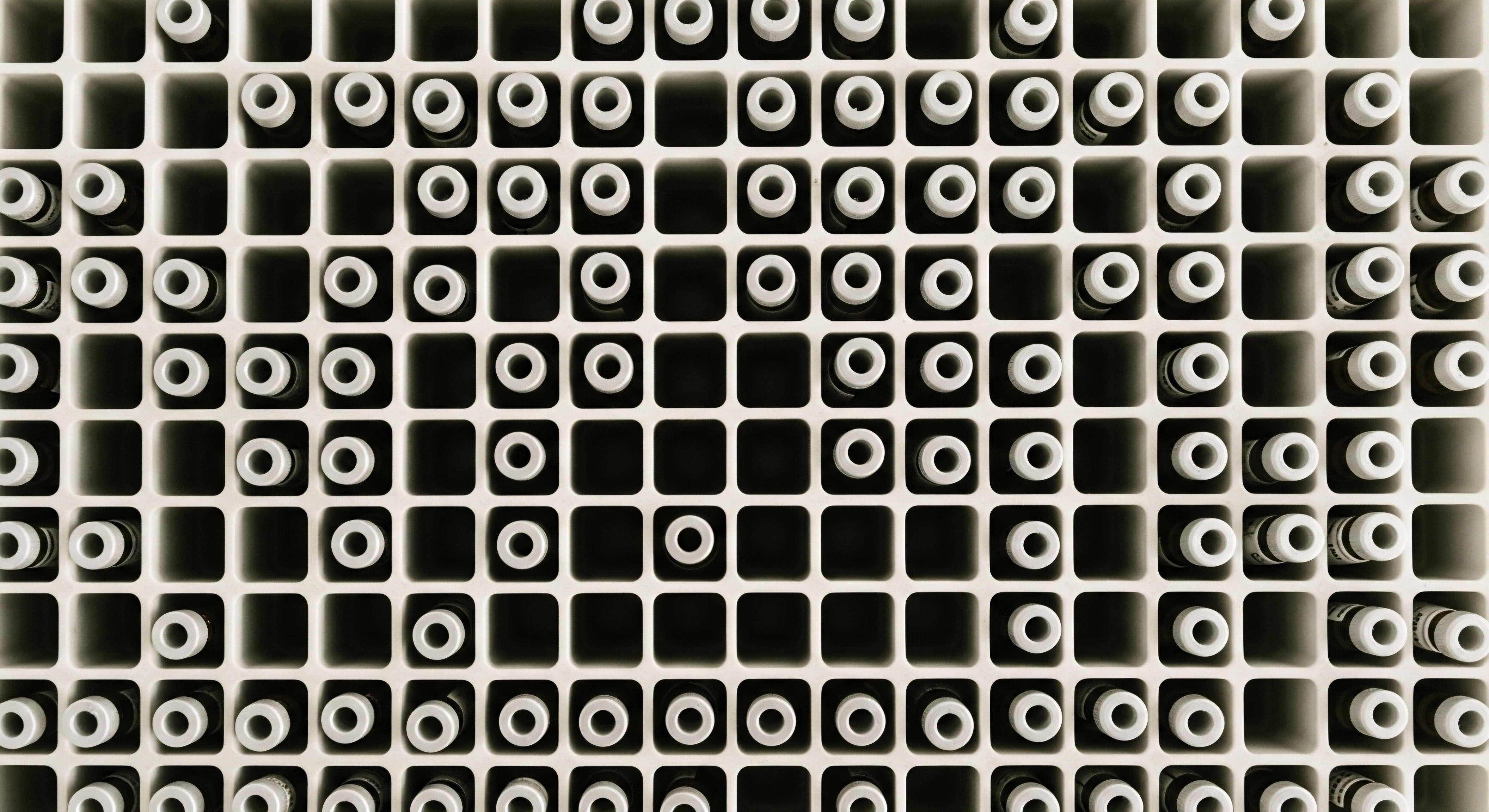

Fundamentals
Experiencing shifts in your body’s internal rhythms can feel disorienting, particularly when those changes touch upon something as fundamental as reproductive potential. Many individuals find themselves grappling with concerns about their future fertility, whether due to a looming medical intervention, a desire to plan for later life, or simply a wish to understand their biological landscape more completely.
This journey of understanding your own systems, of recognizing the subtle signals your body transmits, forms the bedrock of reclaiming vitality and function without compromise. The concept of preserving sperm, known as cryopreservation, stands as a testament to modern medical capabilities, offering a tangible path forward for men facing various life circumstances.
Understanding when sperm cryopreservation becomes a recommended strategy requires a foundational grasp of male reproductive physiology. At its core, male fertility hinges upon the intricate dance of the hypothalamic-pituitary-gonadal (HPG) axis. This sophisticated communication network orchestrates the production of hormones and sperm.
The hypothalamus, a small but mighty region in the brain, releases gonadotropin-releasing hormone (GnRH). This chemical messenger travels to the pituitary gland, prompting it to secrete two crucial hormones ∞ luteinizing hormone (LH) and follicle-stimulating hormone (FSH).
LH primarily stimulates the Leydig cells within the testes to produce testosterone, the primary male sex hormone. Testosterone plays a multifaceted role, influencing everything from muscle mass and bone density to mood and sexual function. FSH, on the other hand, acts directly on the Sertoli cells in the testes, which are vital for supporting and nourishing developing sperm cells, a process termed spermatogenesis.
This delicate balance, a finely tuned feedback loop, ensures a continuous supply of healthy sperm and appropriate hormone levels. Disruptions to any part of this axis can significantly impact fertility, making cryopreservation a consideration for those anticipating such changes.
Sperm cryopreservation offers a proactive measure for men to safeguard their reproductive capacity amidst life’s unpredictable challenges.

Understanding Male Reproductive Hormones
The male endocrine system operates with remarkable precision, with each hormonal signal carrying specific instructions. Testosterone, beyond its well-known roles, is also essential for the initiation and maintenance of spermatogenesis. Without adequate testosterone levels within the testes, the complex process of sperm maturation cannot proceed efficiently. FSH’s direct influence on Sertoli cells ensures the structural and nutritional support necessary for germ cell development, guiding them from their earliest stages to mature spermatozoa.
When external factors threaten this delicate equilibrium, such as certain medical treatments or lifestyle choices, the integrity of the HPG axis can be compromised. This can lead to a decline in sperm production, a reduction in sperm quality, or even complete cessation of spermatogenesis.
Recognizing these potential impacts allows for proactive measures, such as sperm banking, to be considered before irreversible changes occur. The decision to pursue cryopreservation often stems from a desire to preserve options, providing peace of mind for future family planning.


Intermediate
The decision to pursue sperm cryopreservation often arises from specific clinical scenarios where future fertility is at risk. Understanding these circumstances, and the underlying biological rationale for preservation, provides clarity for individuals navigating complex health decisions. This proactive measure is frequently recommended prior to treatments known to impair testicular function or in situations where a man’s reproductive capacity might diminish over time.

When Is Sperm Cryopreservation a Recommended Strategy?
One of the most common indications for sperm cryopreservation involves medical treatments for cancer. Chemotherapy and radiation therapy, while life-saving, can have significant gonadotoxic effects, meaning they damage the cells responsible for sperm production. The extent of damage depends on the type of treatment, dosage, and duration. For instance, certain alkylating agents used in chemotherapy are particularly detrimental to germ cells. Prior to initiating such therapies, banking sperm offers a vital opportunity to preserve fertility.
Surgical interventions also present scenarios where cryopreservation becomes a prudent consideration. Procedures such as orchiectomy (removal of a testis), often performed for testicular cancer, or certain prostate surgeries, can directly impact sperm production or ejaculation. Similarly, men undergoing a vasectomy, a permanent form of male contraception, may choose to cryopreserve sperm beforehand as a safeguard against future changes in family planning desires or unforeseen circumstances.
Beyond medical treatments, certain lifestyle factors or occupational exposures can also warrant consideration for sperm banking. Men working in environments with exposure to specific toxins, high heat, or radiation may experience a gradual decline in sperm quality over time. For individuals in these professions, or those anticipating military deployment to hazardous zones, cryopreservation offers a practical solution to mitigate potential risks to their reproductive health.
Cryopreservation is a strategic choice for men facing medical treatments, surgical procedures, or occupational exposures that could compromise their reproductive future.

Hormonal Interventions and Fertility Preservation
The intersection of hormonal health and fertility preservation is particularly relevant for men considering or undergoing Testosterone Replacement Therapy (TRT). While TRT effectively addresses symptoms of low testosterone, it can suppress the HPG axis, leading to reduced endogenous testosterone production and, critically, impaired spermatogenesis. This occurs because the exogenous testosterone signals the brain to decrease its output of GnRH, LH, and FSH, thereby reducing the natural stimulation for sperm production.
For men on TRT who wish to maintain or restore fertility, specific protocols can be integrated. These often involve medications that stimulate the HPG axis or mitigate the suppressive effects of exogenous testosterone.
- Gonadorelin ∞ Administered via subcutaneous injections, Gonadorelin mimics the natural GnRH, stimulating the pituitary to release LH and FSH. This helps maintain testicular function and endogenous testosterone production, thereby supporting spermatogenesis.
- Clomid (Clomiphene Citrate) ∞ This medication acts as a selective estrogen receptor modulator (SERM). It blocks estrogen’s negative feedback on the hypothalamus and pituitary, leading to increased GnRH, LH, and FSH secretion. This can stimulate natural testosterone production and improve sperm parameters.
- Tamoxifen ∞ Another SERM, Tamoxifen operates similarly to Clomid, blocking estrogen receptors and promoting increased gonadotropin release, which can aid in restoring testicular function and fertility, particularly after TRT cessation.
- Anastrozole ∞ An aromatase inhibitor, Anastrozole reduces the conversion of testosterone into estrogen. While primarily used in TRT to manage estrogen levels and reduce side effects, it can also be considered in fertility protocols to optimize the testosterone-to-estrogen ratio, which can indirectly support spermatogenesis.
These medications are often used in a structured protocol, particularly for men who have discontinued TRT and are attempting to conceive. The goal is to reactivate the body’s natural hormonal pathways to support robust sperm production.
Consider the following comparison of common scenarios and their cryopreservation considerations ∞
| Scenario | Primary Risk to Fertility | Cryopreservation Recommendation | Relevant Hormonal Intervention |
|---|---|---|---|
| Cancer Treatment (Chemotherapy/Radiation) | Direct gonadotoxicity, germ cell damage | Highly recommended prior to treatment | Post-treatment fertility stimulation (Clomid, Gonadorelin) if needed |
| Vasectomy | Permanent obstruction of sperm transport | Recommended for future family planning flexibility | None directly related to vasectomy itself |
| Initiating Testosterone Replacement Therapy (TRT) | Suppression of HPG axis, impaired spermatogenesis | Recommended if future fertility is a concern | Gonadorelin, Clomid, or Tamoxifen alongside/after TRT |
| Occupational Exposure to Toxins | Gradual decline in sperm quality/quantity | Considered for long-term preservation | Lifestyle modifications, antioxidants |

Growth Hormone Peptides and Male Wellness
While not directly linked to sperm cryopreservation, the broader discussion of male hormonal health includes the role of growth hormone peptides. These compounds influence various aspects of metabolic function and overall well-being, which can indirectly support a healthy physiological environment conducive to reproductive health. Peptides like Sermorelin, Ipamorelin / CJC-1295, and Tesamorelin stimulate the body’s natural production of growth hormone. This can contribute to improved body composition, enhanced sleep quality, and accelerated tissue repair, all of which support systemic health.
Other targeted peptides, such as PT-141, address specific aspects of male health, in this case, sexual function. PT-141 acts on melanocortin receptors in the brain to influence libido and erectile function. Pentadeca Arginate (PDA), a different class of peptide, supports tissue repair, healing processes, and inflammation modulation.
While these peptides do not directly impact sperm production or cryopreservation, they represent components of a comprehensive approach to male wellness, recognizing the interconnectedness of all bodily systems. A man’s overall metabolic and hormonal balance contributes to his reproductive vitality.


Academic
The decision to pursue sperm cryopreservation, while seemingly straightforward, rests upon a deep understanding of male reproductive endocrinology and the complex interplay of biological systems. This section delves into the sophisticated mechanisms governing spermatogenesis and how various clinical interventions or external stressors can disrupt this delicate process, making cryopreservation a scientifically sound strategy.

Endocrine Regulation of Spermatogenesis
Spermatogenesis, the continuous production of spermatozoa, is a highly regulated process occurring within the seminiferous tubules of the testes. This process is exquisitely sensitive to hormonal fluctuations, primarily orchestrated by the HPG axis. Follicle-stimulating hormone (FSH), secreted by the anterior pituitary, binds to receptors on Sertoli cells.
This binding initiates a cascade of intracellular signaling pathways, including the activation of adenylyl cyclase and increased cyclic AMP (cAMP) production, which ultimately promotes the synthesis of various proteins essential for germ cell development, such as androgen-binding protein (ABP) and inhibin B. ABP maintains high local concentrations of testosterone within the seminiferous tubules, which is critical for spermatogenesis.
Luteinizing hormone (LH), also from the anterior pituitary, stimulates Leydig cells to produce testosterone. This testosterone then acts locally within the testes (paracrine effect) to support Sertoli cell function and germ cell maturation. Systemic testosterone provides negative feedback to the hypothalamus and pituitary, regulating GnRH, LH, and FSH secretion. Disruptions to this feedback loop, whether from exogenous hormone administration or disease, can profoundly impact sperm output.
The intricate hormonal symphony of the HPG axis governs spermatogenesis, making it vulnerable to external disruptions that necessitate cryopreservation.

Impact of Exogenous Androgens on Testicular Function
The administration of exogenous androgens, such as in Testosterone Replacement Therapy (TRT), provides a compelling example of HPG axis suppression. When supraphysiological or even physiological levels of testosterone are introduced externally, the hypothalamus perceives adequate androgenic signaling and reduces its release of GnRH. This, in turn, diminishes pituitary LH and FSH secretion.
The reduction in LH leads to decreased endogenous testosterone production by Leydig cells, while the decline in FSH directly impairs Sertoli cell function and, consequently, spermatogenesis. This phenomenon, known as exogenous androgen-induced hypogonadism, is a primary reason why fertility preservation is discussed with men initiating TRT who have future reproductive aspirations.
The degree of spermatogenic suppression varies among individuals and depends on the dose and duration of TRT. While some men may experience only oligozoospermia (low sperm count), others may develop azoospermia (absence of sperm). The reversibility of this suppression upon TRT cessation is also variable, influenced by factors such as age, duration of therapy, and baseline testicular function. This variability underscores the importance of proactive cryopreservation.

Strategies for Fertility Preservation and Restoration
For men undergoing gonadotoxic treatments or those on TRT, several pharmacological strategies aim to preserve or restore fertility by modulating the HPG axis.
- Gonadotropin-Releasing Hormone (GnRH) Agonists ∞ While often used to suppress gonadotropins in other contexts, short-term, pulsatile administration of GnRH agonists like Gonadorelin can stimulate endogenous LH and FSH release, thereby supporting testicular function and spermatogenesis. This approach aims to counteract the suppressive effects of exogenous androgens or to reactivate the axis post-treatment.
- Selective Estrogen Receptor Modulators (SERMs) ∞ Medications such as Clomiphene Citrate and Tamoxifen act by blocking estrogen receptors in the hypothalamus and pituitary. By doing so, they remove the negative feedback exerted by estrogen, leading to an increase in GnRH, LH, and FSH secretion. This surge in gonadotropins directly stimulates Leydig cell testosterone production and Sertoli cell function, promoting spermatogenesis. Clinical studies have demonstrated their efficacy in improving sperm parameters in men with idiopathic oligozoospermia or those recovering from exogenous androgen use.
- Aromatase Inhibitors (AIs) ∞ Anastrozole, an AI, inhibits the enzyme aromatase, which converts androgens into estrogens. By reducing estrogen levels, Anastrozole can indirectly increase endogenous testosterone by reducing estrogen’s negative feedback on the HPG axis. While primarily used to manage estrogen levels in TRT, its role in fertility protocols is to optimize the testosterone-to-estrogen ratio, which can be beneficial for spermatogenesis.
The choice of agent and protocol depends on the specific clinical context, including the cause of infertility, the patient’s hormonal profile, and their reproductive goals. A comprehensive evaluation, including detailed hormonal assays and semen analysis, guides these therapeutic decisions.
The following table outlines key hormonal markers and their implications for male reproductive health ∞
| Hormone/Marker | Normal Range (Approximate) | Implication of Low Levels | Implication of High Levels |
|---|---|---|---|
| Total Testosterone | 300-1000 ng/dL | Hypogonadism, reduced libido, fatigue, impaired spermatogenesis | Rarely high endogenously; exogenous can suppress HPG axis |
| Free Testosterone | 50-200 pg/mL | Similar to total testosterone, more biologically active | Potential for increased estrogen conversion, side effects |
| Luteinizing Hormone (LH) | 1.8-8.6 IU/L | Secondary hypogonadism, impaired Leydig cell function | Primary hypogonadism (testicular failure) |
| Follicle-Stimulating Hormone (FSH) | 1.5-12.4 IU/L | Secondary hypogonadism, impaired Sertoli cell function | Primary hypogonadism (testicular failure), impaired spermatogenesis |
| Estradiol (E2) | 10-40 pg/mL | Rarely low in men; can affect bone density | Gynecomastia, water retention, mood changes, HPG axis suppression |
| Sperm Count | 15 million/mL | Oligozoospermia, reduced fertility potential | Normal, indicates healthy spermatogenesis |

Metabolic Health and Spermatogenesis
Beyond direct hormonal regulation, systemic metabolic health significantly influences male reproductive function. Conditions such as obesity, insulin resistance, and metabolic syndrome are increasingly recognized as contributors to male infertility. Adipose tissue, particularly visceral fat, acts as an endocrine organ, producing inflammatory cytokines and increasing aromatase activity. Elevated aromatase leads to increased conversion of testosterone to estrogen, thereby reducing bioavailable testosterone and exacerbating HPG axis suppression.
Chronic inflammation and oxidative stress, often associated with poor metabolic health, can directly damage germ cells and impair sperm motility and morphology. This systemic impact underscores the holistic nature of male reproductive health. Addressing underlying metabolic dysregulation through lifestyle interventions, such as diet and exercise, can complement specific hormonal therapies and contribute to overall fertility potential. The decision to cryopreserve sperm, therefore, often sits within a broader context of optimizing systemic health to support long-term vitality.

References
- Nieschlag, E. & Behre, H. M. (2012). Andrology ∞ Male Reproductive Health and Dysfunction. Springer.
- Boron, W. F. & Boulpaep, E. L. (2017). Medical Physiology. Elsevier.
- Guyton, A. C. & Hall, J. E. (2020). Textbook of Medical Physiology. Elsevier.
- Weinbauer, G. F. & Nieschlag, E. (1995). Gonadotropin-releasing hormone agonists and antagonists in male fertility control. Fertility and Sterility, 63(6), 1127-1134.
- Paduch, D. A. et al. (2014). Testosterone Replacement Therapy and Fertility ∞ Is There a Role for Gonadotropin-Releasing Hormone Agonists? Urology, 83(4), 882-887.
- Shabsigh, R. et al. (2009). The Role of Clomiphene Citrate in the Management of Male Infertility. Journal of Andrology, 30(2), 125-131.
- Esteves, S. C. et al. (2017). Azoospermia ∞ Diagnosis and Management. Springer International Publishing.
- Winters, S. J. & Troen, P. (1982). Pulsatile release of luteinizing hormone and follicle-stimulating hormone in men. Journal of Clinical Endocrinology & Metabolism, 55(3), 560-565.
- Isidori, A. M. et al. (2005). Aromatase inhibitors in men ∞ effects on gonadotropins and gonadal steroids. Journal of Clinical Endocrinology & Metabolism, 90(11), 6511-6518.
- Pasquali, R. et al. (2011). Obesity and male infertility ∞ a pathogenetic link. Journal of Andrology, 32(5), 450-459.

Reflection
Your personal health journey is precisely that ∞ personal. The insights gained from understanding the intricate dance of your hormones and the biological underpinnings of fertility are not merely academic facts. They are tools, offering a deeper appreciation for your body’s capabilities and vulnerabilities. This knowledge empowers you to make informed decisions, to advocate for your own well-being, and to proactively shape your future.
Consider this exploration of sperm cryopreservation not as a definitive endpoint, but as a starting point for introspection. What does reproductive potential mean to you? How do your current health circumstances align with your long-term aspirations? Recognizing the profound connection between your hormonal health, metabolic function, and overall vitality allows for a more integrated approach to wellness.
This understanding can guide you toward personalized protocols, helping you recalibrate your systems and reclaim a sense of robust function. The path to optimal health is a continuous dialogue with your own biology, guided by precise information and a commitment to self-awareness.



